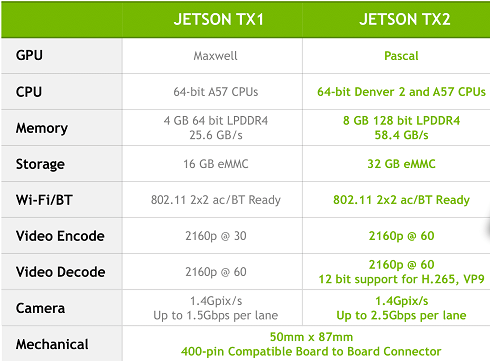
NVIDIA Jetson TX2 Credit card-sized Platform Released
NVIDIA has announced Jetson TX2, a full Linux computer on a tiny board the size of a Raspberry Pi designed to help make robots, drones and other devices that rely on computer vision applications.
The Jetson TX2 joins NVIDIa's Jetson TX1 and TK1 products for embedded computing. Jetson TX2 doubles the performance of its predecessor. Or it can run at more than twice the power efficiency, while drawing less than 7.5 watts of power.

So Jetson TX2 can run larger, deeper neural networks on edge devices. The open platform is accessible to anyone for putting AI to work.
Key features of Jetson TX2 include:
- GPU: 256-core NVIDIA Pascal architecture-based GPU offering best-in-class performance
- CPU: Dual 64-bit NVIDIA Denver 2, Quad ARM A57
- Video: 4K x 2K 60fps encode and decode
- Camera: 12 CSI lanes supporting up to 6 cameras; 2.5 gigabytes/second/lane
- Memory: 8GB LPDDR4; 58.3 gigabytes/second
- Storage: 32GB eMMC
- Connectivity: 802.11ac WLAN, Bluetooth
- Networking: 1GB Ethernet
- OS Support: Linux for Tegra
- Size: 50mm x 87mm

The big change compared to the Jetson TX1 is the upgrade to NVIDIA's newest-generation Parker SoC. Relative to the Tegra X1 in the previous Jetson, Parker is a bigger and better version of the SoC. The GPU architecture is upgraded to NVIDIA's latest-generation Pascal architecture, and on the CPU side NVIDIA adds a pair of Denver 2 CPU cores to the existing quad-core Cortex-A57 cluster. Parker also suupports a 128-bit memory bus, boosting the memory bandwidth available to the SoC. The SoC is fabbed on TSMC's 16nm FinFET process.
Paired with Parker on the Jetson TX2 as supporting hardware is 8GB of LPDDR4-3733 DRAM, a 32GB eMMC flash module, a 2x2 802.11ac + Bluetooth wireless radio, and a Gigabit Ethernet controller. The resulting board is still 50mm x 87mm in size, with NVIDIA intending it to be drop-in compatible with Jetson TX1.
NVIDIA is canonizing two performance modes on the TX2: Max-Q and Max-P. Max-Q is the company's name for TX2's energy efficiency mode; at 7.5W, this mode clocks the Parker SoC for efficiency over performance, with NVIDIA claiming that this mode offers 2x the energy efficiency of the Jetson TX1.
Meanwhile the board's Max-P mode is its maximum performance mode. In this mode NVIDIA sets the board TDP to 15W, allowing the TX2 to hit higher performance at the cost of some energy efficiency. NVIDIA claims that Max-P offers up to 2x the performance of the Jetson TX1.
The Jetson family is supported by a comprehensive SDK for AI computing, JetPack 3.0, which makes it easy to integrate AI into applications, and support the following:
- TensorRT 1.0, a high-performance neural network inference engine for production deployment of deep learning applications
- cuDNN 5.1, a GPU-accelerated library of primitives for deep neural networks
- VisionWorks 1.6, a software development package for computer vision and image processing
- The latest graphics drivers and APIs, including OpenGL 4.5, OpenGL ES 3.2, EGL 1.4 and Vulkan 1.0
- CUDA 8, which turns the GPU into a general-purpose massively parallel processor
The NVIDIA Jetson TX2 Developer Kit, which includes the carrier board and Jetson TX2 module, can be preordered today for $599 in the United States and Europe and will begin shipping March 14. It will be available in other regions in the coming weeks. The Jetson TX2 module will be available in Q2 for $399 (in quantities of 1,000 or more) from NVIDIA and its distributors around the world. NVIDIA has also reduced the price of the Jetson TX1 Developer Kit to $499.





















